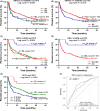Genetic variants of cell cycle pathway genes predict disease-free survival of hepatocellular carcinoma
- PMID: 28639733
- PMCID: PMC5504311
- DOI: 10.1002/cam4.1067
Genetic variants of cell cycle pathway genes predict disease-free survival of hepatocellular carcinoma
Abstract
Disruption of the cell cycle pathway has previously been related to development of human cancers. However, associations between genetic variants of cell cycle pathway genes and prognosis of hepatocellular carcinoma (HCC) remain largely unknown. In this study, we evaluated the associations between 24 potential functional single nucleotide polymorphisms (SNPs) of 16 main cell cycle pathway genes and disease-free survival (DFS) of 271 HCC patients who had undergone radical surgery resection. We identified two SNPs, i.e., SMAD3 rs11556090 A>G and RBL2 rs3929G>C, that were independently predictive of DFS in an additive genetic model with false-positive report probability (FPRP) <0.2. The SMAD3 rs11556090G allele was associated with a poorer DFS, compared with the A allele [hazard ratio (HR) = 1.46, 95% confidential interval (95% CI) = 1.13-1.89, P = 0.004]; while the RBL2 rs3929 C allele was associated with a superior DFS, compared with the G allele (HR = 0.74, 95% CI = 0.57-0.96, P = 0.023). Additionally, patients with an increasing number of unfavorable genotypes (NUGs) of these loci had a significant shorter DFS (Ptrend = 0.0001). Further analysis using receiver operating characteristic (ROC) curves showed that the model including the NUGs and known prognostic clinical variables demonstrated a significant improvement in predicting the 1-year DFS (P = 0.011). Moreover, the RBL2 rs3929 C allele was significantly associated with increased mRNA expression levels of RBL2 in liver tissue (P = 1.8 × 10-7 ) and the whole blood (P = 3.9 × 10-14 ). Our data demonstrated an independent or a joint effect of SMAD3 rs11556090 and RBL2 rs3929 in the cell cycle pathway on DFS of HCC, which need to be validated by large cohort and biological studies.
Keywords: Cell cycle pathway; hepatocellular carcinoma; single-nucleotide polymorphism; survival.
© 2017 The Authors. Cancer Medicine published by John Wiley & Sons Ltd.
Figures


References
-
- Chen, W. , Zheng R., Baade P. D., Zhang S., Zeng H., Bray F., et al. 2016. Cancer statistics in China, 2015. CA Cancer J. Clin. 66:115–132. - PubMed
-
- Torre, L. A. , Bray F., Siegel R. L., Ferlay J., Lortet‐Tieulent J., and Jemal A.. 2015. Global cancer statistics, 2012. CA Cancer J. Clin. 65:87–108. - PubMed
-
- Farinati, F. , Rinaldi M., Gianni S., and Naccarato R.. 2000. How should patients with hepatocellular carcinoma be staged? Validation of a new prognostic system. Cancer 89:2266–2273. - PubMed
-
- Llovet, J. M. , Bru C., and Bruix J.. 1999. Prognosis of hepatocellular carcinoma: the BCLC staging classification. Semin. Liver Dis. 19:329–338. - PubMed
-
- Chatterjee, R. , and Mitra A.. 2015. An overview of effective therapies and recent advances in biomarkers for chronic liver diseases and associated liver cancer. Int. Immunopharmacol. 24:335–345. - PubMed
MeSH terms
LinkOut - more resources
Full Text Sources
Other Literature Sources
Medical

